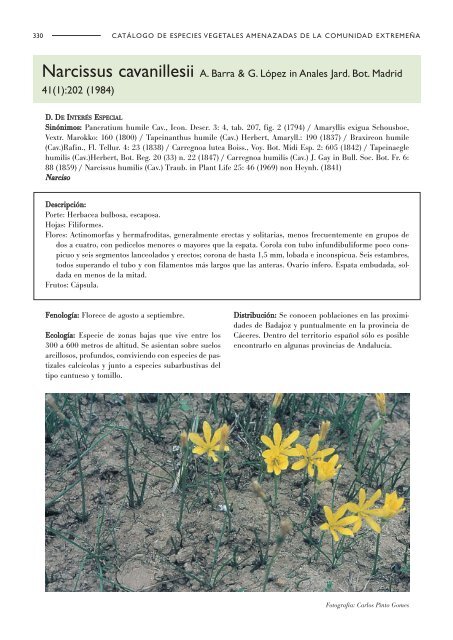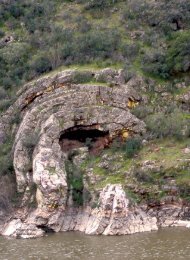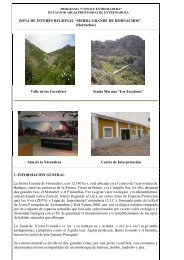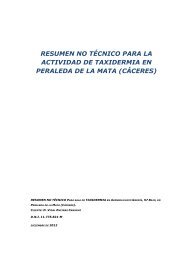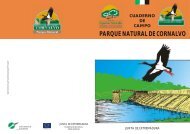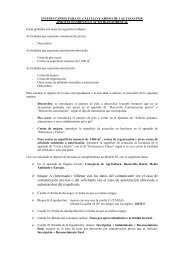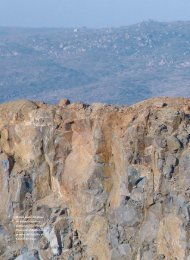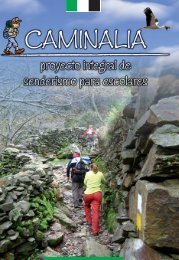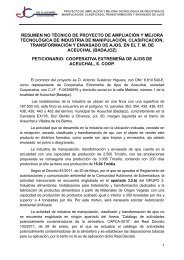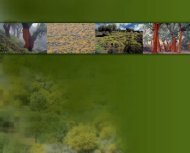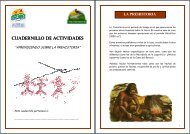angiospermas - Extremambiente.es
angiospermas - Extremambiente.es
angiospermas - Extremambiente.es
You also want an ePaper? Increase the reach of your titles
YUMPU automatically turns print PDFs into web optimized ePapers that Google loves.
330 CATÁLOGO DE ESPECIES VEGETALES AMENAZADAS DE LA COMUNIDAD EXTREMEÑA<br />
Narcissus cavanill<strong>es</strong>ii A. Barra & G. López in Anal<strong>es</strong> Jard. Bot. Madrid<br />
41(1):202 (1984)<br />
D. DE INTERÉS ESPECIAL<br />
Sinónimos: Pancratium humile Cav., Icon. D<strong>es</strong>cr. 3: 4, tab. 207, fig. 2 (1794) / Amaryllis exigua Schousboe,<br />
Vextr. Marokko: 160 (1800) / Tapeinanthus humile (Cav.) Herbert, Amaryll.: 190 (1837) / Braxireon humile<br />
(Cav.)Rafin., Fl. Tellur. 4: 23 (1838) / Carregnoa lutea Boiss., Voy. Bot. Midi Esp. 2: 605 (1842) / Tapeinaegle<br />
humilis (Cav.)Herbert, Bot. Reg. 20 (33) n. 22 (1847) / Carregnoa humilis (Cav.) J. Gay in Bull. Soc. Bot. Fr. 6:<br />
88 (1859) / Narcissus humilis (Cav.) Traub. in Plant Life 25: 46 (1969) non Heynh. (1841)<br />
NNaarrcciissoo<br />
D<strong>es</strong>cripción:<br />
Porte: Herbacea bulbosa, <strong>es</strong>caposa.<br />
Hojas: Filiform<strong>es</strong>.<br />
Flor<strong>es</strong>: Actinomorfas y hermafroditas, generalmente erectas y solitarias, menos frecuentemente en grupos de<br />
dos a cuatro, con pedicelos menor<strong>es</strong> o mayor<strong>es</strong> que la <strong>es</strong>pata. Corola con tubo infundibuliforme poco conspicuo<br />
y seis segmentos lanceolados y erectos; corona de hasta 1,5 mm, lobada e inconspicua. Seis <strong>es</strong>tambr<strong>es</strong>,<br />
todos superando el tubo y con filamentos más largos que las anteras. Ovario ínfero. Espata embudada, soldada<br />
en menos de la mitad.<br />
Frutos: Cápsula.<br />
Fenología: Florece de agosto a septiembre.<br />
Ecología: Especie de zonas bajas que vive entre los<br />
300 a 600 metros de altitud. Se asientan sobre suelos<br />
arcillosos, profundos, conviviendo con <strong>es</strong>peci<strong>es</strong> de pastizal<strong>es</strong><br />
calcícolas y junto a <strong>es</strong>peci<strong>es</strong> subarbustivas del<br />
tipo cantu<strong>es</strong>o y tomillo.<br />
Distribución: Se conocen poblacion<strong>es</strong> en las proximidad<strong>es</strong><br />
de Badajoz y puntualmente en la provincia de<br />
Cácer<strong>es</strong>. Dentro del territorio <strong>es</strong>pañol sólo <strong>es</strong> posible<br />
encontrarlo en algunas provincias de Andalucía.<br />
Fotografía: Carlos Pinto Gom<strong>es</strong>


